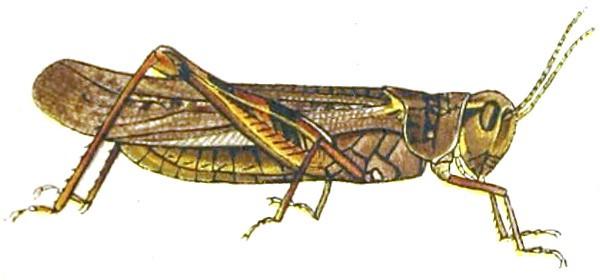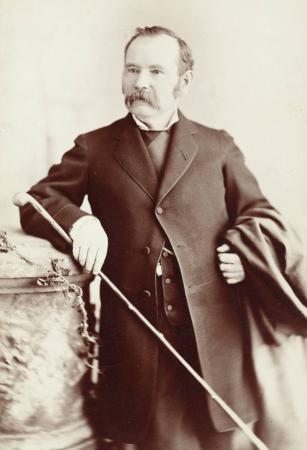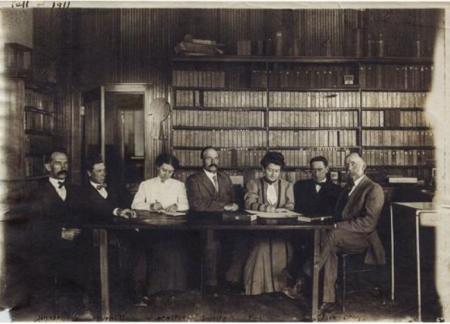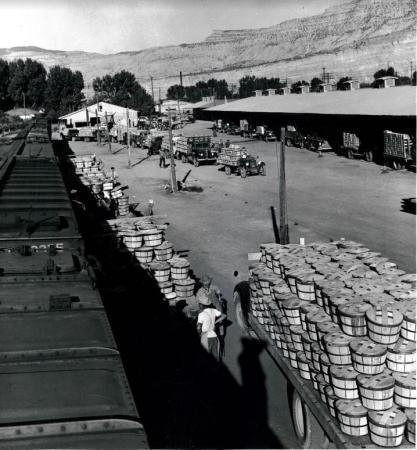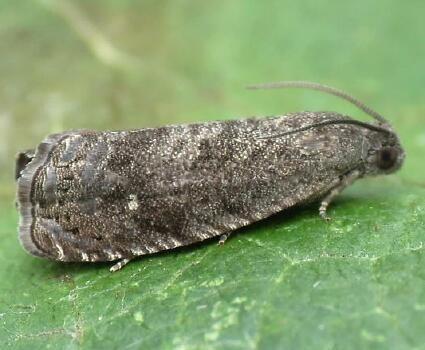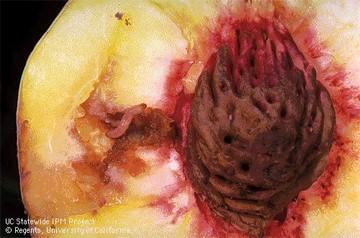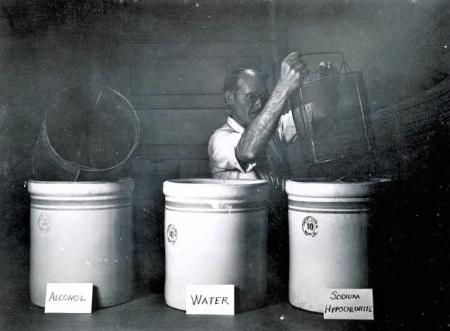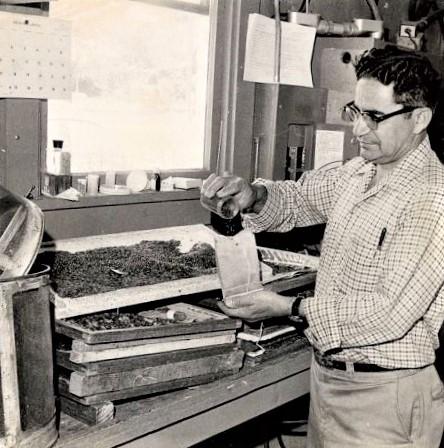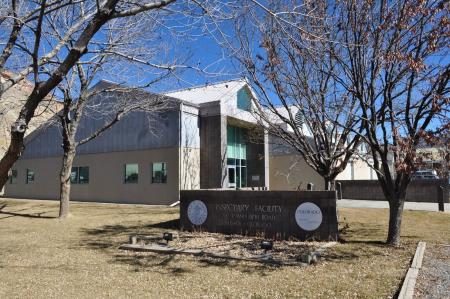Palisade Insectary History
The Colorado Department of Agriculture (CDA) has promoted the use of biological control in pest management since the 1940s. At that time, the Palisade Insectary first released biocontrols (parasitic wasps) for use against the Peach moth in the fruit-growing regions of the Grand Valley. The program was a success and continues to this day. Following this first success other biocontrol agents were released for a number of insect pests, and then for some of the most difficult-to-control noxious weeds. The Insectary releases and monitors about 20 different species of biological control agents for use against both weeds and insect pests.
Biocontrol Timeline
- 1876 First Government Response to Agricultural Insect Pests in Colorado
Not found since 1905 and considered extinct, the Rocky Mountain Locust, Melanoplus spretus, periodically decimated Colorado agriculture before Colorado was even officially a state. A particularly bad plague in 1875 prompted the Secretary of War to designate a $138,000 appropriation to provide relief in the way of food and clothing to farmers whose livelihoods were harmed by the locusts. This marked the first official government response to insect pests in Colorado.
- 1876 Governor Routt, First Governor of Colorado
In his inaugural address, Governor Routt focused on locust plagues and urged an appropriation of tax dollars to fund " the investigations of the history, haunts, and means of exterminating this pest…”. This was the first of many agricultural and economically significant pest species to be addressed by Colorado’s government.
- 1907 Office of the State Entomologist Created
Formed in 1907, the Office of the State Entomologist was only the second agricultural regulatory agency in Colorado. The office focused on nursery and orchard inspections for the growing agricultural industry. Of particular concern was the possible importation of non-native insects and plant diseases that could go unchecked without the natural enemies from their native range.
- 1933 Colorado Division of Agriculture Established
The creation of the Division of Agriculture by the code bill of 1933 established the first state agency devoted to agriculture. Several disparate offices and boards were combined and placed under sections of the new Division. One of the sections created under this new division was the Bureau of Plant and Insect Control with the state entomologist as the acting chief, again highlighting how important insects and control of plant pests has been in Colorado.
- 1939 Mesa County Peach Growers Establish the Board of Control
The rapid and large growth of the peach industry on the Western slope encouraged growers to band together to create a Board of Control to regulate the industry and ensure high quality and fair pricing of their fruit. Eleven representatives were named to the board that oversaw shipping, pricing, advertising, and the grade and size regulations of peaches for all growers. The BOC would also consult with the state entomologist for emerging pests and diseases to ensure a stable and profitable peach market.
- 1944 Peach Moth Found in Grand Valley of Colorado
In 1944 a voracious moth was accidentally introduced into the Grand Valley of Colorado by way of rail cars. The Peach Moth, Grapholitha molesta, threatened the entire orchard industry as its larval would eat their way through apples, pears and peaches, ruining the fruit. F. Herbert Gates, the state entomologist, had recently come back from a trip to California where he had observed parasitic wasps, called “Mac” for Macrocentrus ancylivorus, being raised and released to combat peach moth. Plans were quickly made to create an Insectary to raise these beneficial insects and protect the orchard industry.
- 1945 Palisade Insectary is Opened
In 1944 a resolution was passed by the Mesa County Board of Control and the Colorado Department of Agriculture to begin mass rearing Macrocentrus ancylivorus for control of Peach Moth. The location chosen was the original Board of Control building at 1st and Main in Palisade, Colorado. The small house had been outfitted with a new lab room, two rearing rooms, an office and basement. When the doors were opened on August 14, 1945, the Palisade Insectary became one of the first ever government funded programs for biological control in the United States.
- 1946 First Field Release of Laboratory Reared "Mac"
Beginning in January of 1946, potato tuber moths were shipped from the established Mac nurseries in California to the Palisade Insectary. The workers at the Insectary were able to establish a stable lab population by March of the same year and were ready to begin receiving Mac. The first parasitized cocoons were separated in a wash by April and field releases began immediately. In the first year of rearing, 250,000 Mac were released in the orchards of the Grand Valley.
- 1951 Mac is Shipped for Control of Strawberry Leaf Roller
The introduction of Mac for control of peach moths in the Grand Valley was highly successful and in 1951, no peach moths were trapped in Mesa County. Around the Fort Collins area, strawberry leaf roller had started becoming a significant pest of the strawberry industry. Some testing with Mac and strawberry leaf roller had shown promising results and so 6,000 Mac were shipped to the strawberry fields. This was the first shipment out of the Grand Valley of biological control agents from the Palisade Insectary. The venture proved successful and subsequent shipments of Mac for control of strawberry leaf roller were made to the State of Washington.
- 1952 First Foreign Exchange of Biological Control Agents
As biological control became more widespread and successful, foreign cooperative agreements were created to exchange biocontrol agents. The first foreign exchange of agents came when the Palisade Insectary received Coccophagus insidiator and Trichomasthus sp. from the French Ministry of Agriculture for the control of European elm scale. This pest was infesting thousands of urban shade trees in Colorado and chemical control was prohibitively expensive. These foreign agents quickly became established and were able to be collected and redistributed by the following year with much success.
- 1968 Insectary Greenhouses Acquired
In 1968, the Insectary expanded operations by building a greenhouse to grow host plants for the insects being raised in culture. The first plants to be grown and utilized were alfalfa for the propagation of the pea aphid parasitoid Diaretiella rapae. Greenhouse operations continue to be a very important aspect of the Palisade Insectary.
- 1992 New Insectary Building is Built
Construction funds for a new Insectary facility were obtained from the Colorado Lottery program in 1992. The current Palisade Insectary has 13,000 square feet of laboratory and rearing space, 1,200 square feet of greenhouse space, and approximately 3 acres of grounds for field experimentation.
